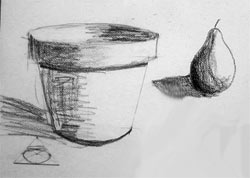

How to draw round objects
MATERIALS LIST
Hover Or Click
A Color For Information
Burnt Sienna
A sedimentary color; sediments quickly offering a mottled or shimmery look to the final (wash)
+ close +Viridian
A sedimentary color; sediments quickly offering a mottled or shimmery look to the final (wash)
+ close +Pthalocyanine Blue
A "warm" (greenish) blue.
A non sedimentary color settles out smoothly yielding a uniform finish (wash)
+ close +Pyrrol Red
A "warm" (orangish) red.
A non sedimentary color settles out smoothly yielding a uniform finish (wash)
+ close +Arylide Yellow FGL
A "warm" (orangish) yellow.
A non sedimentary color settles out smoothly yielding a uniform finish (wash)
There is not an industry standard name for this color. I am offering DaVincis Brand name.
+ close +Yellow Ocher
A sedimentary color.
sediments quickly offering a mottled or shimmery look to the final (wash)
+ close +Cerulean Blue
A sedimentary color.
Sediments quickly offering a mottled or shimmery look to the final (wash)
+ close +Ultramarine Blue
A cool (purplish) blue.
A non sedimentary color settles out smoothly, theoretically yielding a uniform final (wash).
Actually Ultramarine Blue "flocculates" (gathers in clumps) so we only get a fairly smooth (wash)
Sadly, it's the only purplish blue thats light-fast and available to artists.
+ close +Alizarin Crimson
( Quinacridone )
A cool (purplish) red.
A non sedimentary color settles out smoothly yielding a uniform finish (wash)
n fact, Alizarine Crimson (a very early man made pigment) lost favor when it was found non light-fast.
Today we replace it it with a better version of the same color called Quinacdridone Red.
Nevertheless, manufacturers still call it Alizerine Crimson.
+ close +A cool (greenish) yellow
A non sedimentary color settles out smoothly yielding a uniform finish (wash)
There is not an industry standard name for this color. I am offering the DaVincis Brand name.
+ close +Three point perspective is really the basis for all linear perspective. How it translates to round objects is not obvious. This lesson explains it.

It assumes that you have taken the previous two lessons; one point, and three point perspective.
The lesson demonstrates that a circle looks like a circle only if viewed from the perpendicular to the circle. If you view it obliquely, it will be an ellipse. If you view it on edge, its going to be a straight line.
We look at how round objects appear in the real world. The example used is a flower pot viewed from just above the plain of the top. We study how the arcs and ellipses relate to one another using the principles of linear perspective. Its quite easy. Try it, you'll see.
Next we draw a pear. Making it round is a snap.
 Drawing Lesson One -(Single) One Point Perspective
Drawing Lesson One -(Single) One Point Perspective
 Drawing Lesson Two - Three Point Perspective
Drawing Lesson Two - Three Point Perspective
 Drawing Lesson Three - How TO Draw Round Objects
Drawing Lesson Three - How TO Draw Round Objects